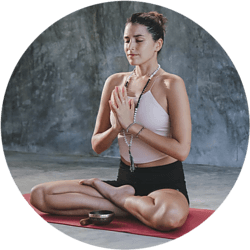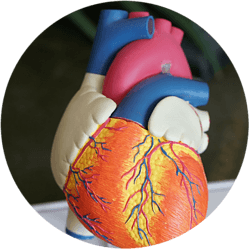Yogic breathing is a fundamental practice in the study of yoga and is aimed at increasing vital energy in the body and mind. In this post, we shall see “What is Yogic Breathing” and how we can re-program your natural breathing process to enhance the quantity and quality of prana i.e. life force.
Yogic breathing is often referred to as pranayama. The practice of pranayama dates back to ancient Indian Yogis who identified the power of breathing and developed specific breathing techniques to nourish the mind and body. The Yogis mastered the art of controlling the breath and trained the body to breathe in a particular fashion, which helped them to re-program their natural breathing process to improve general health and well being.
It is indeed astonishing to know that once you master the art of breathing, you start healing yourself. It is so easy to take the simple act of breathing for granted and surprisingly the majority of us do not use the full capacity of our respiratory organs.
How Does Yogic Breathing Work
Yogic breathing is a practice that helps to regulate our breath and expand the flow of prana i.e. life force through energy channels in our b odies, often referred to as nadis.
odies, often referred to as nadis.
With ever-increasing incidence of lifestyle ailments and stress, we all hold physical and emotional blocks in our bodies which in some sense restrict the flow of breath and of prana (i.e. life energy). This can make us feel unwell, disinterested, stuck, and moody. By practicing yogic breathing regularly we can clear these blockages (both emotional & physical) so that breath and prana can flow freely.
When prana flows freely through your body’s different subtle energy channels (nadis) and energy centers you inevitably feel healthier, stronger, more grounded, and more inspired. You feel more full of prana (energy) and therefore more full of life.
Related Post: Learn How To Unfold The Secret Breath Effortlessly With Pranayama
How Our Breathing Affects Our Emotions
Have you noticed the connection between your emotions and breathing? Perhaps ‘Yes’ – However the majority of us do not give breathing as much attention as it deserves hence we never learn to harness the full potential of our breath.
 Conscious breathing helps us in changing the way we feel, this happens because of a strong connection between breathing and emotions. Different emotional states are associated with distinct respiratory patterns. For every emotion, there is a rhythm, so when you cannot directly harness your emotions, with the help of breath you can do that. For instance, when you feel afraid or anxious then your breath is more quick and shallow, whereas when you are joyful then your breath is slow and full.
Conscious breathing helps us in changing the way we feel, this happens because of a strong connection between breathing and emotions. Different emotional states are associated with distinct respiratory patterns. For every emotion, there is a rhythm, so when you cannot directly harness your emotions, with the help of breath you can do that. For instance, when you feel afraid or anxious then your breath is more quick and shallow, whereas when you are joyful then your breath is slow and full.
Interestingly, everyone talks about changing our emotions by using the power of thoughts, however very few are aware that their own breath can become a very potent tool to change their emotions. Once you identify this power of controlling and regulating your breath then you can literally compel your breath to be slow and thereby create a state of deep relaxation and contentment – Can you imagine how revolutionary and useful this can be?
The key here is to develop a daily routine of breath awareness and practice ten minutes of relaxed breathing once or twice daily. This will help you understand the interaction between emotions and your breath. As you start paying attention to this, you will discover the power to alter the natural process of breathing patterns and mindfully change the depth, rate, and pattern of breathing to shift the balance of energy within the body.
Benefits of Yogic Breathing
Incorporating yogic breathing as a part of our daily routine provides a multitude of physical, emotional, and mental health benefits.
1. Lowers Stress & Anxiety Levels

Yogic breathing helps in controlling our autonomic nervous system. If you are wondering what is an autonomic nervous system – It consists of the sympathetic and parasympathetic nervous systems.
In general sympathetic nervous system governs our responses to threats or stress. It tells our body how to react to stressful situations or dangers. It is also referred to as fight or flight response. Whereas, the parasympathetic nervous system helps the body calm back down after the danger or stressor has passed.
Simple deep and rhythmic breath activates the parasympathetic nervous system and induces the body to relax more. This in turn helps to lower the stress and anxiety levels in the body.
2. Improves Digestion
There is a famous saying “There is a brain in the head and there is also a brain in the gut “. Yogic breathing stimulates the brain activity, which in turn improves the digestion.
As you practice the breathing technique, during inhalation the stomach sinks in, and during exhaling the stomach expands out. This stomach movement is quite beneficial for the surrounding muscles that include the liver and pancreas. As the blood flow and supply of oxygen increases to these areas, it aids digestion and removes acidity and gas related problems. There are also studies that prove that regular breathing practice is also beneficial for belly fat loss.
3. Treats Sleep Disorders

We spend one-third of our life in sleep and to a large extent, it is this one third which decides two-third of our life. I am referring to the quality of sleep, a healthy body needs quality sleep. Total wellness is impossible without good sleep. Sleep disorders are rising in society since the time we have become 24×7.
Yogic breathing is the answer for people who are suffering from insomnia. It increases blood circulation, stimulates the nervous system, and improves oxygenation to the brain, this in turn leads to better quality sleep. Start performing yogic breathing regularly to get a sound sleep free of negative thoughts and nightmares.
4. Improves Functioning of Brain
Yogic breathing is also found to be beneficial in improving brain power and mental health. A daily routine of yogic breathing increases oxygen supply to the brain and nourishes brain cells and helps them function at optimal levels. Slow, deep breathing also helps to calm the mind and makes it free from anxiety.
A peaceful mind awakens inner strength, it helps you to take charge of your thoughts, your concentration increases as there are fewer distractions. Your mind becomes well oriented, efficient, and active. There are studies that show that breathing exercises increase the volume of grey matter in the brain and is effective for brain disorders.
5. Improves Cardiovascular Health & Lungs

Daily breathing exercises help in expansion of chest walls and lungs, this in turn improves the lung capacity and its functions. Slow deep breathing leads to the strengthening of respiratory muscles. As your lungs start to function to the maximum capacity, it leads to positive changes like treating many lung diseases like asthma, bronchitis, and other occupational diseases.
The practice of yogic breathing regularly also strengthens your cardiovascular health. It improves the circulation of blood & oxygen through arteries, veins, and makes the circulatory system efficient. There are various studies that show that breathing exercises lead to a significant reduction in heart rate and improves blood pressure.
Your Breathing Body: Your Breath Is The Gateway To The Vastness Of The Universe
How To Do Yoga Breathing
Often the first breathing technique taught to new yoga practitioners is Three-Part Breath. It is also called as Dirgha Pranayama. The “three parts” are the abdomen, diaphragm (rib cage), and chest. It is the most simple and calming breathing exercise you can learn to get in tune with the sensations of your physical body and focus your attention on the present moment.
1. Position: You can practice the three-part breath while seated on a chair with your feet flat on the floor or sitting cross-legged on the yoga mat or lying down fully extended in Corpse Pose. At the start of the practice, lying down on the back can help you in really feeling the breath moving through your body as it makes contact with the floor.
2. Preparation: Spend a minute to settle yourself, ensure you are comfortable, without distraction. Begin the practice by noticing your breath, the smooth inhalation, and exhalation of your breath without changing anything.
3. Part 1: Place your hands on the belly (just above the navel) As you inhale, fill the belly up with your breath. Expand the belly with air like a balloon. Feel your hands expand as the belly moves. As you exhale, push out all the air from the belly through your nose. Feel your hands contracting as you draw your navel back towards your spine. Repeat this for about three rounds.
4. Part 2: Place your hands on your ribs and inhale. Expand the belly again, as the belly is full, draw in a little more breath and fill the rib cage. Allow the ribs to expand in all directions. As you exhale, let the air go first from the rib cage and then from the belly. As you exhale you will feel hands contracting as the ribs slide closer together. Repeat this for about three rounds.
5. Part 3: Place your hands on your upper chest. As you inhale fill the belly, rib cage with air, and draw in a little more breath fill the upper chest as it expands all the way to your collar bone. As you exhale, push the air go first from the upper chest, then from the rib cage, and finally from the belly. Repeat this for about three rounds.
6. Complete Breath: Practice these three parts separately until you are confident that you are doing them correctly, then put all the parts together as one continuous complete breath.
Be careful never to force the breath or to breathe too deeply. Remember to keep it easy and relaxed. You can practice it many times throughout your day, even two or three breaths will have a positive effect on your body and mind. Do it regularly to reap the benefits of yogic breathing in all areas of your life. If you have any questions post below in the comments.
Related Post: Learn How To Unfold The Secret Breath Effortlessly With Pranayama


Hi Satish,
Thanks for the informative post, I am one of the many that never made the connection between my breathing and my mood. I am going to work on your steps and hopefully I can experience all of the benefits, once I get it figured out of course.
Thanks,
Tyler
Hi Tyler,
I hope this post helped you to figure our the connection between breathing and emotions? I suggest you start a regular practice of breathing for about 5 minutes daily and take it from there. The key is to sustain the practice to experience the benefits and discover the power of breathwork. Wishing you all the very best ~ Stay Blessed 🙂
Hi Satish,
I use breathing practices similar to this to combat my anxiety, if not exactly like this. I also practice yoga. So I am going to have to implement this breathing into my yoga practices. I love doing yoga and I find the hardest part for me is keeping my breath regulated. Thanks for these tips!
Hi Erika,
As you are already practicing Yoga, you will know that one can practice as many yoga poses as they like. However, if deep breathing isn’t taking place, the practice will not benefit the body. Breathing is what causes the movement of energy and what helps the body relax. When we breathe deeply, we can open ourselves to feel more emotion, as well as be more in tune with what’s happening in our bodies. Wishing you all the best ~ Stay Blessed 🙂
Hello Satish,
I have heard of this form of breathing, but I never knew what it was actually called! Now i understand that it is called as Yogic Breathing. I currently practice breathing techniques similar to what you explained above. You explained everything so clearly and it was an easy read. I intend on following your tips in my routine. Very helpful!
Thank you,
Emily
Hi Emily,
I am happy to know that you have breathing practice in place and found this post useful ~ Stay Blessed 🙂
Hi Satish,
Thanks for this article letting us know the benefits about a yogic breathing. I think it’s quite comprehensive and easy to follow, especially the last step-by-step part of guiding us on how to do yoga breathing. I must admit that I practice while I read the words you explain the process which seems to calm me down a bit, so I will squeeze some time for this from my daily routine.
Cheers,
Matt
Hi Matt,
Glad to know that you practiced Yogic Breathing as you read the post, make sure you take 5 minutes daily and incorporate as a part of your daily routine. Breathing is a free tool which we all have at our disposal to use it anytime and anywhere, so I am sure you will be to find time for this ~ Stay Blessed 🙂
Hi Satish,
A very concise and informative post. My girlfriend has been suffering from some anxiety lately and tells me she finds it difficult to breathe sometimes which I’ve noticed, I taught her some simple breathing exercises but I know that there might be more that she can do to lower her stress levels, this post has everything I need and I want to try yogic breathing out with her as it’s something that I myself can see benefiting from. Thank you
Hi Kevin,
Yes you both can start a breathing practice together, it will help you to unite and be more in tune with each other ~ Stay Blessed 🙂
Hi Satish,
Very informative article on What is Yogic Breathing and How To Practice. I would like to start practicing these techniques and share with my friends. Thank you for this informative article. One quick question: When is the best time to practice Yogic Breathing ?
Hi Alyse,
Anytime you can incorporate more breath awareness into your life, the better. Though, a particular good time of the day to practice Yogic Breathing is the morning. The more you tune into the energy of morning, the more it can help you set the tone for a better day ~ Stay Blessed 🙂